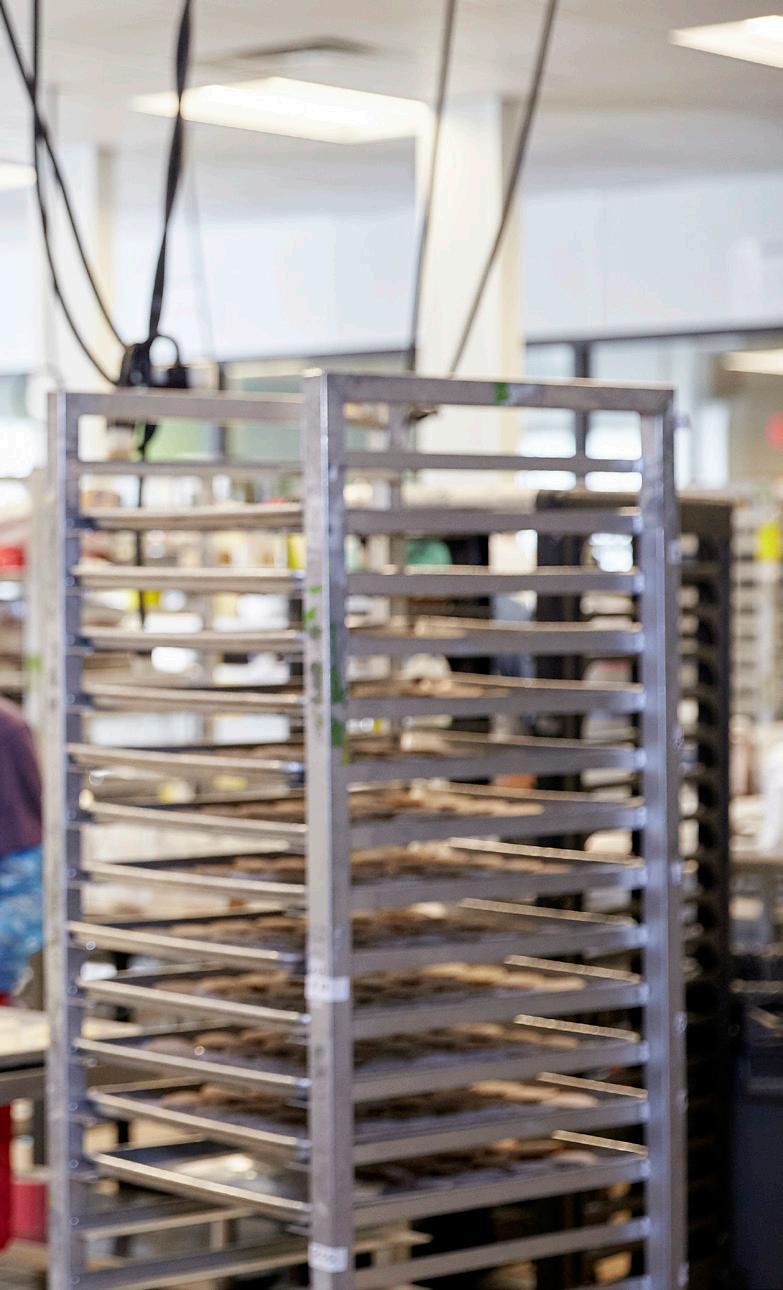
27 minute read
Just Add Engineers to the Mix
from Georgia Grown
WORDS: MICHAEL BAXTER
41
Advertisement
FOR THE STATE’S FOOD MANUFACTURERS, A GEORGIA TECH PARTNERSHIP IS THE SECRET INGREDIENT TO GROWTH
CRAIG BROMLEY
42
ou would expect a building where vinegar is made to have a sour smell, highly pungent, perhaps with a whiff of apple. World Technology Ingredients (WTI) smells nothing like this. Their manufacturing facility, off a county two-lane in Jefferson, Georgia, has a vaguely mineral aroma. More dry than dank, and not altogether unpleasant.
Maybe that’s because the vinegar made here isn’t destined for grocery store shelves, but for food preservation. It’s called buffered vinegar, an all-natural additive that protects meats and other products from microbes. WTI makes a lot of this vinegar, more than they used to in fact, and that’s partly because of Damon Nix.
On this Friday afternoon, Nix is taking a visitor through WTI’s plant, pointing out its sectors and stations. Here’s the wet vinegar, seven titanic tanks and even more smaller ones, emitting a hiss-and-motor chorus of mechanized blending. Over here’s the powdered version, mixed in towering contraptions on chalky floors (that will later be cleaned), then heated, blended and bagged.
Nix stops at a white board with dry-erase markings that tell another story of what’s going on inside the plant — one of continuous improvement. Sketched out are five days of the work week, four areas of focus (safety, performance, schedule, issues) and an assortment of metrics. One of WTI’s workers happens by, and after glancing at the white board, Nix congratulates him.
“I think y’all are doing great,” he says. “These are good numbers.”
Nix doesn’t work for WTI. He’s an industry manager for the Georgia Manufacturing Extension Partnership, or GaMEP, a Georgia Tech-based, engineering-centric program that helps small and mid-sized manufacturing companies in the state perform better. As the partnership’s food and beverage point person, Nix applies his industrial engineering education from Tech to help manufacturers up their game and lower their costs.
“What I really do is facilitate problem solving,” says Nix (B.S., ISyE, ’01). He is careful to emphasize the facilitation part. He doesn’t arrive as the dreaded efficiency expert, handing down mandates and new processes to those on the floor. Rather, he operates as the quintessential engineer — conducting research, listening to people, and fostering ownership of change. When he introduces new knowledge, such as time-tested principles of lean manufacturing and quality control, it’s more as a coach guiding a player who’s motivated to improve.
43
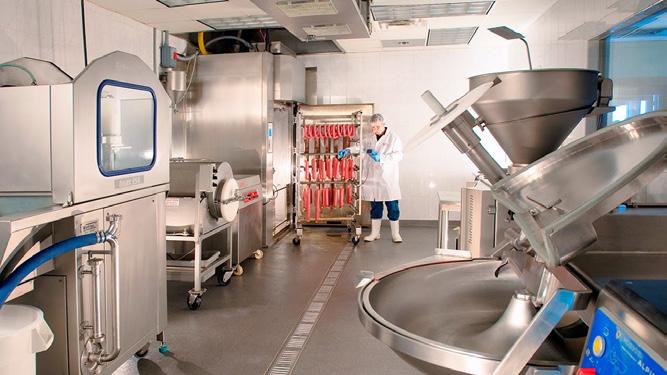
World Technology Ingredients (WTI) is a leader in the food safety and ingredient industry, working closely with food processors to enhance product flavor and boost product quality. PHOTOS COURTESY WTI
“In organizations that really succeed, teams are empowered by top management,” he says. “The team has to own the process. I could go to a meeting and offer a bunch of ideas, but half of them wouldn’t be nearly as good as what people inside the company put forward and act on.”
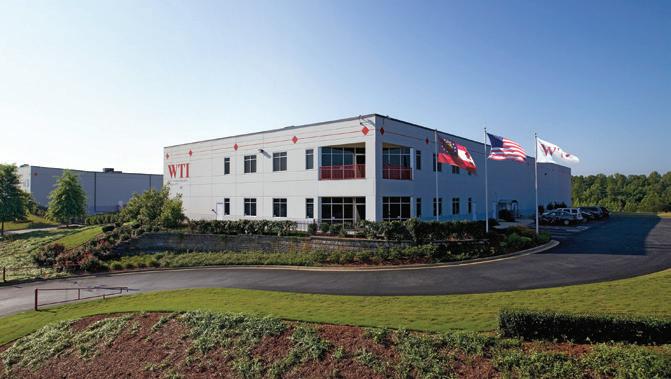
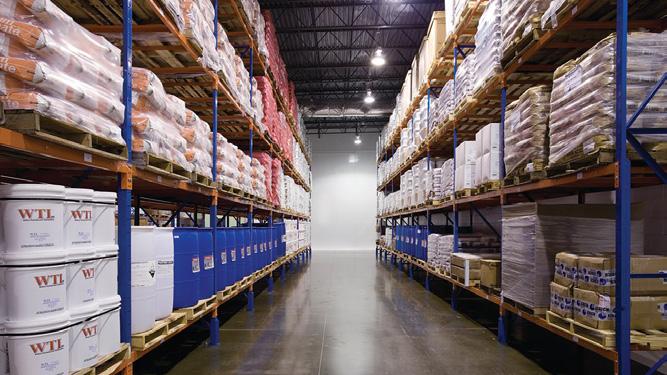
Rise of an engineering partnership
Georgia Tech has been in the game of helping small and mid-sized manufacturers for a long time. A century ago, the idea of creating an engineering counterpart to America’s agricultural experiment stations was being debated in Congress. But the Georgia General Assembly didn’t wait for the debate to conclude — it voted in 1919 to launch an “engineering experiment station” (EES) at Georgia Tech.
Curiously, lawmakers didn’t fund the new enterprise. It wasn’t until 1934, midway through the Great Depression, that EES got its first state allocation of $5,000 and was assigned an acting director, Harry Vaughn, who described the experiment station as “Georgia’s first agency designed to aid in a comprehensive development of industry.”
In 1960, the General Assembly ratcheted up Georgia Tech’s assistance to industry, passing a bill to form an Industrial Extension Service as part of the earlier EES. That authorized Georgia Tech to create field offices around the state to provide “technical advice and assistance to local development groups and to establish(ed) business and industry.” The new service was the forerunner of today’s GaMEP. The partnership sharpened its focus on manufacturing in 1988 after Congress passed a national program, the Hollings Manufacturing Extension Partnership. The Industrial Extension Service later designated GaMEP as one of 70 MEP affiliates.
44
(EES, by the way, later became GTRI, the Georgia Tech Research Institute.)
GaMEP, which turns 60 next year, is today housed inside Georgia Tech’s Enterprise Innovation Institute — a good fit, given its economic development focus. With 10 offices throughout Georgia, it now has a solid track record of helping small and mid-sized manufacturers grow. One of these is Dalton-based Precision Products, which manufactures a wide range of parts to order and has achieved two crucial ISO certifications that opened the door to new customers and industries. Sales grew by more than $3.5 million. And Goldens’ Foundry and Machine Co., a 130-year-old enterprise, wanted to strengthen employee communication and problem solving. GaMEP helped them introduce a management system designed to bring company conversations to the plant floor and improve information flow.

Packaging insight into food processing
One area historically underserved by GaMEP is the food and beverage industry. “It’s the state’s top manufacturing sector,” Nix says, “yet it had not been our number one customer.” So, in 2016, he was assigned to develop an initiative to broaden and deepen partnerships with businesses in the industry.
Driving much of the food and beverage industry’s growth in Georgia are companies of 50 or fewer employees. These are the makers of local craft beers, hometown jellies and artisan mustards. Nix says about eight of 10 food processing companies fit that size profile, though they are dwarfed in sales by the other 20 percent, the larger manufacturers.
So he developed a market analysis and concluded that super-sizing a commitment to food and beverage would

45
46
be a good fit. The demand was there, too. Food processing employs nearly 70,000 Georgians and accounts for $12 billion of the state’s GDP every year, according to a 2016 report from Georgia Power. Since GaMEP stepped up efforts to serve the industry in 2017, the average number of projects with food and beverage companies more than doubled, from 20 to 45.
When asked to describe the greatest problems facing these manufacturers, Nix quickly cites compliance with safety regulations, which, to a small food business, run from complex to bewildering. “If you’re in a business of 10 to 20 people, you may not have a food scientist on staff,” he says. “So, you’ve got to figure out compliance on your own, or else bring in consultants.”
Safety, he notes, is more than just following protocols in production. It involves attending to details in reporting and paperwork, all the way down to the product label. Nix shares the cautionary tale of an Oregon maker of seasonings that neglected to include hazelnuts in its list of ingredients on the label. “Of course, nut allergies are a huge issue,” he says. “That one mistake could have ruined their entire product distribution. The damage to the brand, and the cost of bringing back the brand, is so significant.”
While GaMEP knew it could help food companies in an array of ways — from process management to energy usage to business growth — leaders found they had a gap in food science expertise. Food science determines the safety profile of every jar, tin, box and bag of product. So they brought in a food manufacturing safety whiz, Wendy White, who had experience overseeing a portfolio of food products. White is now leading a new GaMEP program on safety, funded by a three-year grant totaling nearly $1 million.
For the ingredients company WTI, the primary challenge has not been safety but improving processes and efficiency. When asked what impact he’s seen from GaMEP’s help, Stephan Georg, the company’s director of strategic sourcing, recounts a conversation between a shift foreman and consultant in front of one of the Gemba white boards.
“The foreman said the plan was to make two batches of a product,” Georg says, “but the consultant answered,
‘Well, I think you can do five batches. The foreman thought that was unrealistic. So we brought in Georgia Tech, and the first thing Damon does is conduct time studies. It gave us that baseline information we needed. After that groundwork, we determined that three batches would be a good goal.”
Since then, Nix has visited with workers from WTI’s round-the-clock shifts and consulted with management. Together, they work through improvements born out of lean manufacturing, which are processes engineered to reduce waste and improve customer satisfaction. The goal is to reach 40 percent overall equipment effectiveness for producing buffered vinegar, a metric built on several components of the manufacturing process.
More recently, Nix introduced a new tool to these efforts: A software platform called Impruver, developed out of Georgia Tech’s Advanced Technology Development Center (ATDC). It’s designed to help small and mid-sized manufacturers of consumer products spot trends in metrics, track performance and monitor ongoing issues. “It’s great to have another entity inside ATDC working with us and our clients,” Nix says.
While all of GaMEP’s contributions are welcomed, Stephan Georg has special praise for the non-engineering side of Damon Nix. “While he looks at the facts and explains things in a scientific way, he also treats people here with respect,” Georg says. “They see that he’s not here to get them fired. He’s the guy who’s here to help.”

in the field
Inside the Physiology of Wearable Robotics Laboratory, engineers lay the groundwork for a range of devices that could help children, stroke patients, the elderly, and amputees gain more independence and move with greater comfort and ease. Much of this work is done through a local partnership with
Children’s Healthcare of Atlanta.
49
ASHLEY RITCHIE
Swinging Through the Fields
Engineers are building a new type of robot, and it’s going to revolutionize farming
Ai-Ping Hu

Awoman stands in a soybean field in Athens, Georgia, baking in the summer sun as she leans down to measure the angle at which a leaf wilts toward the earth. She’s a graduate researcher trying to determine which of the soybean varieties planted in the field are most resistant to the oppressive heat and lack of rain. She wipes sweat from her brow and continues down the row. This is the seventh time this summer she has made her way through this soybean field, meticulously taking measurements.
She’s researching soybean phenotypes — the outward expression of each plant’s genetics. Researchers plant various strains of the same crop, like soybeans, and then meticulously study acres of plants in order to determine which strain is most drought resistant. Hopefully, this will be one of her last summers manually monitoring the plants — advances in automation are just around the corner. Georgia Tech robotics engineers are in the final stages of refining technology that can automate the tedious and time-consuming process of examining crops.
“Since [researchers] have all these genetic varieties, the only way they can tell which ones will thrive in arid environments and propagate is to do testing like this,” said Ai-Ping Hu (MS and PhD, Mechanical Engineering), the principal investigator for this project and a researcher in the Food Processing Technology Division of the Georgia Tech Research Institute. “It’s basically in vivo testing. Whatever the natural soil conditions are, whatever’s in the air, that’s
50
The brachiating robot team shown during testing in a soybean field. (L-R: Jonathan Rogers, Georgia Tech; Ai-Ping Hu, GTRI; Adam Garlow, Mechanical Engineering undergraduate; Evan Davies, Robotics Ph.D. student; Siavash Farzan, Robotics Ph.D. student; Zenglu Li, University of Georgia; Clint Steketee, University of Georgia Plant Genetics Ph.D. student. AI-PING HU

all taken into account. You can’t replicate that experiment in an inside laboratory.”
Georgia Tech engineers have come up with what they think is the perfect way to automate phenotype studying: a robot that swings on cables suspended above the fields. It might sound like something from the future, but the swinging robot is very real. It moves via “brachiation,” which is the technical term used to describe the ways primates swing from tree to tree. Brachiation is an entirely new form of robotic movement, and Georgia Tech researchers are the first in the world to develop a robot that brachiates on flexible cables. Researchers say it is more energy efficient and adaptable than other forms of robotic movement.
Hu and his team are developing the robot in partnership with the UGA Soybean Breeding and Molecular Genetics Laboratory to more efficiently conduct field research. However, Hu speculates that the robot could become a valuable asset to farmers as a persistent, rather than intermittent, tool to monitor crops.
51
In the center of the brachiating robot is a small platform that houses sensors, such as thermal detectors or 3D cameras. Two arms extend from the platform, each bearing a grasper with the ability to precisely sense where the cable is and when to clamp around it. The movement of the machine is reminiscent of a child swinging on a jungle gym; it swings from one arm until it has enough momentum for the other arm to reach up and catch the next portion of the cable.
Mechanical devices such as unmanned aerial vehicles have begun to be used to survey fields. However, these drones must be flown by humans and only for short periods of time. In comparison, the brachiating robot uses very little power and could use small solar panels to charge during the day and independently traverse the fields via wires at night. Plus, nighttime monitoring would be advantageous, because plants exhibit some of their most distinctive behaviors after the sun sets, such as respiration and opening of the leaf pores.
One of the challenges in developing the brachiating robot has been designing specific electronics and software for the hardware components of the machine.
“We have inertial measurement units that allow us to determine how fast the different linkages are moving, how fast the body is moving, and where they are in space,” said Michael Bick, an undergraduate student in mechanical engineering. “We use all of that information, constantly updating as we swing to try to follow the ideal path that uses the least amount of power required.”
The robot is unlikely to entirely replace farm workers any time soon. They still must carefully determine whether fruit and nuts are ripe before picking them. However, the robot may be able to augment the workforce where labor is lacking. A Georgia immigration law in 2011 caused laborers to leave the state, and the state lost $140 million of crops that were left unpicked. With the brachiating robot as a tool for persistent monitoring, farm owners may be able to better determine which plants are ripe, and which may need more attention.
The robot is far from finished. The most recent development in the project was the addition of “wrists” for the robot that would allow it to turn 90 degrees and swing onto an adjacent parallel wire. Instead of traveling along a line, the brachiating robot could cover the entire 2D plane of a crop field.
In the not-so-distant future, instead of graduate researchers trudging through a field of soybeans, you might see primate-like robots swinging around on wires above fields, making sure plants are healthy and Georgia families are fed and full.
‣POLLY OUELLETTE

52
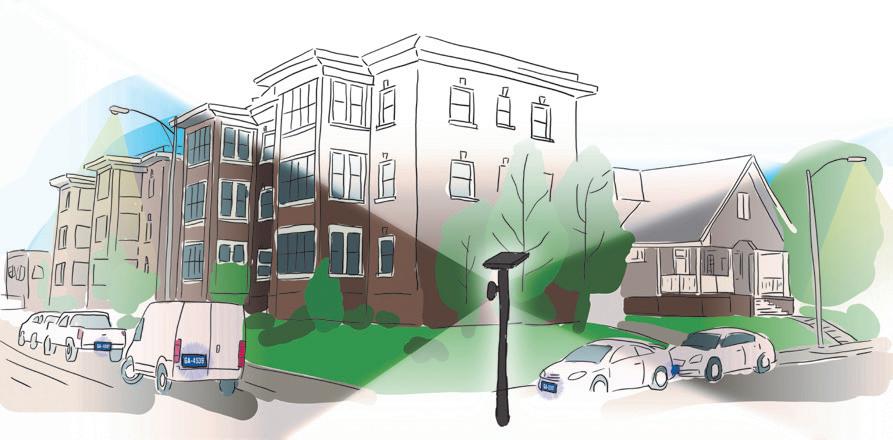
Enhancing Security through Technology
Two Tech alumni use machine learning and better equipment to make neighborhoods in more than 400 cities in Georgia and across the country more secure with Flock Safety
A Flock Safety camera securely captures images while the proprietary machine learning algorithm identifies a vehicle fingerprint, including license plate, vehicle type and vehicle color. I n 2017, Garrett Langley noticed an uptick of burglaries and break-ins in his new Atlanta neighborhood over the winter holiday season. Concerned for his safety and that of his neighbors, he called the local police to ask for some help and discovered that with little concrete evidence, not much could be done to find the perpetrators.
“People have a false perception that grainy surveillance footage will help detectives find criminals,” says Langley, a 2009 electrical engineering alumnus and a HOPE scholarship recipient. “But in reality, they need at least a license plate number to make any real moves.”
In order to capture license plate information that the local police could use, Langley thought about buying and installing security cameras, but they each cost $25,000. Why, he wondered, was it so expensive to provide quality safety and security services when affordable, first-class camera hardware is so ubiquitous today?
Langley called up his friend and fellow alumnus Matt Feury (Computer Science ’11) so they could brainstorm ways to build a less expensive, more effective security solution. Combining off-the-shelf components with the latest in machine learning, the duo had the beginnings of a viable product.
“Within 60 days, our cameras helped make an arrest by helping the police obtain the actionable evidence they needed to find the perpetrator,” Langley remembers. “So Matt and I
53
thought, ‘What if we spend more than a couple of weeks on this project — how big can we go?’”
HELPING POLICE AND CITIZENS WORK TOGETHER
And so, Flock Safety went from great idea to new company and is currently in use in 34 states across the U.S., helping solve a crime five times every hour. In more than 100 cities from Jersey Village, Texas, to Richmond, California, it is the primary source used by police departments to solve non-violent crimes.
Using an automatic number-plate recognition (ALPR) system that securely captures images, Flock Safety’s proprietary machine learning algorithm identifies a vehicle fingerprint, including license plate, vehicle type, and vehicle color. Data is stored securely and privately in the cloud and is easily searchable by both police and citizens through a footage portal.
Flock Safety is making a big impact here in Georgia — after the Marietta Police Department installed a trial license plate reader in a local neighborhood, crime rates dropped 34% over an eight-month period, leading them to make moves on purchasing 10 additional Flock Safety cameras.
Marietta police spokesperson Chuck McPhilamy calls the Flock Safety cameras an important part of “a combined package [that] has led to a decrease in crime.”
Likewise, Sandy Springs residents Carren and Stone Sellers were happy that Flock Safety cameras had recently been installed in their neighborhood when someone broke into their daughter’s car while it was parked in their driveway, stealing a laptop and other valuables. The Sellers asked Flock Safety for help, and the Crime Team helped them through the entire process, from reporting the incident to local police to letting law enforcement know that they could access key footage of the burglar’s vehicle leaving the neighborhood.
“The rule of thumb is that non-violent crime — break-ins, theft, smash and grabs — are crimes of opportunity and convenience, and statistically you only have a one-in-10 chance of getting caught,” explains Langley. “Criminals think, ‘It’s easy for me to break into your car and not get arrested, so I’ll do it.’”
Flock Safety takes the smartphone supply chain and builds software on top of it to help
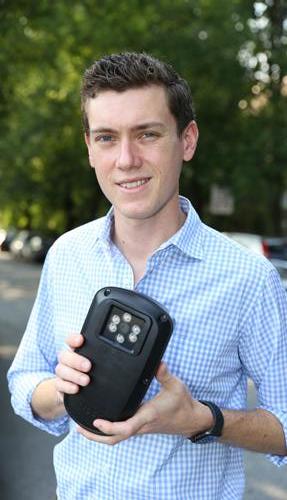
Garrett Langley
cameras interpret what they’re seeing. So instead of just seeing a blurry picture of a car, the camera acts like a detective and can determine that it sees, for example, a blue Honda CRV with damage on the passenger side door and a GA license plate from Fulton County.
TAPPING INTO GEORGIA TECH CONNECTIONS
When working on taking Flock Safety from an at-home project to a full-fledged business, Langley made a call to his senior design project mentor Steve Chaddick, a fellow electrical engineering alum and mentor capitalist at Ridgewood Advisors.
“When we first got started, I hadn’t touched a circuit board in 10 years,” recalls Langley. “Steve played a critical role early on, giving us both technical and business advice to help us stay on top, since so many tech companies fail in the beginning stages.”
As they look to the future, Langley sees partnerships popping up in even more cities and states, as well as facilitating larger deployments with municipalities around the U.S. As police departments begin using Flock Safety, they can partner with the public to purchase their own cameras and help expand the coverage area.
“Flock Safety wouldn’t work nearly as well as it does if it was solely consumer or solely police,” says Langley. “Law enforcement is a challenging industry, and Flock Safety is a force multiplier that helps municipalities do their job better by streamlining the resources they use. In our experience, the safest scenario is a 50/50 split between police and citizens installing and using our cameras. The more we work together, the stronger we are.”
Langley credits his time at Georgia Tech with instilling in him the know-how and inquisitiveness to make Flock Safety a reality.
“Georgia Tech teaches you curiosity, which led Matt and me to question, ‘Why is the incumbent solution of standard home security systems so expensive? Should it be or is this a market opportunity in disguise?’ Because of this line of questioning and the foundation of knowledge we gained at Tech, we have developed a far superior product that is less expensive, does a better job, and has shaken up the home security marketplace.”
‣KATHRIN HAVRILLA-SANCHEZ
54
CRAIG BROMLEY
Helping Georgia’s Students Take Flight

How the Georgia Space Grant Consortium is supporting the state’s aerospace industry and helping students shoot for the stars Stephen Ruffin Director, GSGC
Thirty 14-year-olds stand in a rural Georgia field about to launch a high altitude balloon 100,000 feet into the sky. For the past three weeks, their physics class has been learning how to use this massive inflatable to measure the weather, calculate the data, and track air pressure.
For a number of these students, this is the first time that science and engineering make sense and feel exciting. And it’s all due to the Georgia Space Grant Consortium (GSGC), which provides the resources and support for young students to obtain an insider’s view of the aerospace industry — and maybe even kickstart a few career ambitions along the way.
FLYING HIGH IN GEORGIA
Housed under Georgia Tech’s Guggenheim School of Aerospace Engineering — home to one of the oldest and largest aerospace programs in the country — GSGC is a NASA program dedicated to increasing the number of Georgia students who are interested in science, technology, engineering, and mathematics (STEM) fields. The Consortium aims to
55
support space and aeronautics programs today and well into the future.
Every year, GSGC provides STEM education and hands-on activities at schools and science centers to 10,000 Georgia residents and supports professional development of more than 4,000 K-12 educators across the state.
“Our goal is to reach out to all parts of the state — both metropolitan and rural — and touch as many populations as possible,” says Dr. Stephen Ruffin, director of GSGC. “Half of the people we interact with are women — which far exceeds the overall aerospace industry percentage of 25 percent — and 40 percent are underrepresented minorities.”
GSGC offers everything from summer and academic year science programs for K-12 students, to college internships at NASA and local aerospace companies, to funding for science centers and planetaria across the state, to hands-on teacher trainings.
BRINGING AEROSPACE TO THE CLASSROOM
In June 2019, GSGC sponsored several K-12 teachers for LiftOff Summer Institute, an aerospace-focused workshop held in Texas that emphasizes STEM learning experiences by incorporating different NASA mission areas.
“When I was accepted to LiftOff, they put me in touch with GSGC to help with funding,” says Miranda Fritchman, a sixth-grade science teacher at Clarke Middle School in Clarke County. “We’re a small, Title 1 school, so having GSGC pay the entrance fee made it possible for me to attend.”
Along with her fellow K-12 teachers from around the U.S., Fritchman spent weeks at Johnson Space Center learning from NASA personnel, including Apollo 11 and 13 astronauts and engineers. With more of an earth science background, Fritchman was pleased that LiftOff helped her supplement her aerospace knowledge, as well as provided some hands-on learning elements so students can connect better to the material.

Stephen Ruffin
“Students are enthusiastic about STEM, but they’re also scared of it,” says Fritchman. “Sixth grade is the first time they have dedicated science classes, so now is the time to help them learn how to think like a scientist, answer questions and test hypotheses.
“I also met a lot of people from NASA who came up through unconventional pathways. Many of my students feel like they can’t have an amazing career because they don’t come from the right neighborhood or background, so now I can show them with real examples that you can do it — everything is within your reach.”
GSGC AT GEORGIA TECH
As the leading institution and affiliate of GSGC, Georgia Tech has strong connections to the program. GSGC supports Tech’s Ramblin’ Rocket Club, which recently won the Spaceport America Cup competition with Sustain Alive, a 13.5-foot, 110-pound rocket that reached an altitude of 28,140 feet. GSGC also provides paid research fellowships to Georgia Tech graduate students to work closely with faculty, as well as sponsors programs that provide hands-on engineering internships to Atlanta-area high school students.
“So much of engineering is teamwork, and we infuse that into courses at Tech and in the programs through GSGC,” says Ruffin. “We support innovation by offering a strong STEM background, as well as fostering creativity and an environment in which students feel heard and have the confidence to speak up.”
Looking ahead, GSGC will sponsor more educational opportunities for teachers, such as at the ninth annual Georgia NASA STEM Conference, which provides more than 100 Georgia educators with hands-on activities and presentations by NASA Education Specialists and other NASA program members. In addition, GSGC continues their outreach into Georgia’s school districts with new K-12 programs, including Georgia Outreach Team for Space, which leverages students from Tech to build a STEM network across the state through presentations, demonstrations and mentorship.
‣KATHRIN HAVRILLA-SANCHEZ
Aerospace is big business in Georgia: The state ranks eighth in industry employment in the U.S., and nearly 200 aerospace companies operate out of Georgia, from Lockheed Martin to Gulfstream to Boeing, as well as the world’s busiest airport. Aerospace products are Georgia’s primary export, totaling $9.1 billion annually, according to the Georgia Department of Economic Development.
56
10 TO END
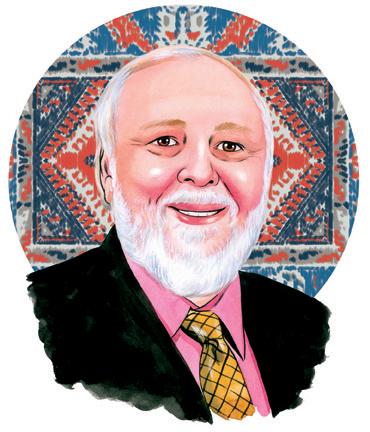
JOEL KIMMEL
10 Questions with Fred Cook
Carpet means big business in Georgia, and Tech professor Fred Cook has been instrumental in bringing cutting-edge textile and polymer chemistry research to the industry. Starting in the 1970s through research and consulting, he helped the likes of Shaw Industries create today’s carpet capital of Dalton, just 90 miles outside of Atlanta. Cook is an alumnus and professor emeritus in the School of Materials Science and Engineering (MSE). Outside the halls of academia, he has also served as an expert witness in high-level patent court cases. He also makes time to take care of his horse and cattle farm in Jackson. 1 ‣Where are you from? Jackson, Georgia. 2 ‣When did you graduate from Georgia Tech? In 1971, I got my bachelor’s in textile chemistry. Back then, it was the School of Textile Engineering. Today, it’s the School of Materials Science and Engineering. In 1975, I was the forerunner of the Textile Engineering Ph.D. program, but, officially, I earned my doctorate in organic polymer chemistry. 3 ‣What is your role at Tech? I am professor emeritus in MSE and retired three years ago. 4 ‣ What got you interested in textile research? It actually goes back to when I was in high school. I’d already been accepted into chemical engineering at Tech. A group of faculty came by the high school, recruiting for what was then the school of textiles. There was one guy, Gerald Fletcher, who gave me a quote I never have forgotten. He said, “Chemical engineering goes up and down, depending on what the oil market is doing. But as long as we don’t go nude, people will always need clothes.” That made good sense to me. 5 ‣Why is Dalton, GA, the carpet capital of the world? Well, the whole industry developed out of Dalton, Georgia. The forerunner to it was the chenille bedspread industry. In the early 1900s, a woman in the mountains of North Georgia came up with this idea of tufted chenille bedspreads, and her sons formed an industry around the concept, developed the machinery and automated it, and started producing chenille bedspreads for the masses. After WWII, they had the idea of using a cheaper nylon fiber that could be tufted and glued to create a carpet floor covering that the public could afford. Up until then, carpet was woven from wool yarns and very expensive. The cheaper tufted carpet essentially made the floor covering available to the general public. By adapting and modifying the chenille bedspread machinery, tufted nylon carpet with woven backing gave us today’s modern floor covering. The bottom-line, Dalton is the carpet capital of the world because about 90 percent of the tufted carpet that’s made in the U.S. is made within about 60 miles of downtown Dalton. 6 ‣What is Tech’s role in the carpet industry? Well, it’s been two-fold, historically. First, we’ve supplied the industry with world-class graduates. As the industry literally exploded starting in the ’50s and ’60s, they needed solid technical people to come in to grow and expand the industry. What better place to look for engineers and scientists than Georgia Tech? Shaw Industries especially took the lead in hiring Tech folks. That’s how Shaw Industries became so prominent. They did wondrous things. Second, through joint research and development projects, Tech made contributions to new technologies for the industry. 7 ‣How has your research helped to improve the carpet industry in our state? By 1975, The School of Textile Engineering was already starting to supply the industry with a significant number of graduates. We also became the fundamental research arm for the carpet industry. We had the contacts; we had our graduates there; and there was just tremendous synergism that we were able to develop. Though companies like Shaw are very, very successful, even they can’t set up a fundamental, ground-up, Ph.D.- driven research operation. 8 ‣What do you see as the number one innovation that Tech has been a part of within the carpet industry? Definitely stain-resistant topical finishes for nylon carpet. These fluoropolymer finishes gave the carpet stain-proof resistance to spills of liquids like grape Kool-Aid and coffee. As an example of how we partnered with the industry, I developed a process that sprayed powder fluoropolymer directly into the carpet tufts, followed by a melt stage to coat the surface. This process not only protected against stains, it saved energy and cut down on pollution, as it was a totally dry application. 9 ‣What was it like being an expert witness in court? I was involved in some large trials. For example, two Taiwan-based companies entered into a patent war over seam technology in men’s and women’s dress shirts. I served as an expert witness. We gave our side guidance, testified in the court case itself, and plotted strategy. It was high stakes drama with multi-million-dollar implications.10 ‣What is your favorite fabric? Tufted carpet. It’s the epitome of engineering and design.
Georgia Institute of Technology 225 North Avenue NW Atlanta, Georgia 30332-0360 coe.gatech.edu
parting shot

Once again, Georgia Tech is graduating more female engineers than any other institution in America. #TheFutureIsFemale #HelluvaEngineer



